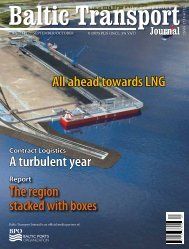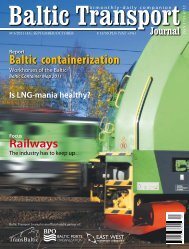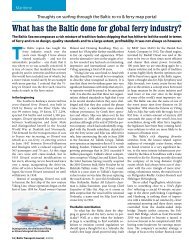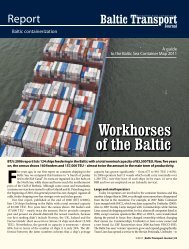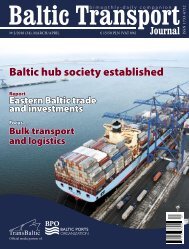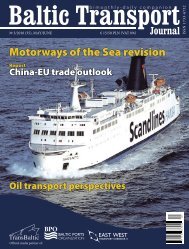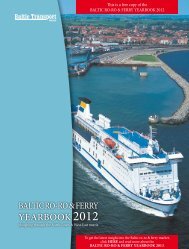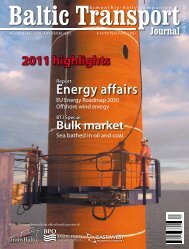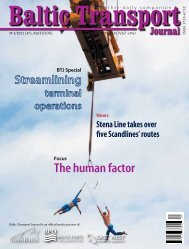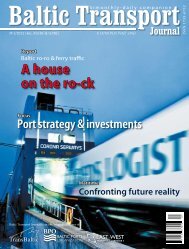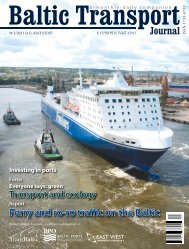You also want an ePaper? Increase the reach of your titles
YUMPU automatically turns print PDFs into web optimized ePapers that Google loves.
Hamburg: a port as a tourist attraction<br />
Face to face with giants<br />
A port as a tourist attraction –<br />
they really know how to achieve<br />
this in Hamburg.<br />
“Metropolis on Water” – this slogan is used<br />
to attract tourists, students, and investors from<br />
all over the world to Hamburg. No other city<br />
or region in Germany can boast of such an impressive<br />
growth of visitors. But the goal of the<br />
city is to join the elite top ten European tourist<br />
destinations.<br />
In the past several years Hamburg has invested<br />
much in its tourist infrastructure, thus<br />
creating a basis for the development of this<br />
sector. The most important investments include<br />
the development of the Congress and<br />
Fair Centre, an airport, and the new terminal<br />
for cruisers. In the future an impressive concert<br />
house on the river bank, the “Elbphilharmonie”,<br />
and the new Hafen-City real estate will<br />
emphasize attractiveness, development and the<br />
port atmosphere of Hamburg.<br />
Last year the number of nights spent by<br />
visitors, which is the most reliable indicator of<br />
tourism development, amounted to 7.4m, an<br />
increase of 3.1%. Germans represented 79% of<br />
the total number of tourists in Hamburg last<br />
year with 21% of foreigners. Arising tourism<br />
from Europe, Russia and Arab countries, as<br />
well as low-cost airlines’ expansion are of crucial<br />
importance for these developments.<br />
A bit of history…<br />
However, the “Metropolis on Water” involves,<br />
first of all, water and the port. In this<br />
respect Hamburg is unique among world harbour<br />
cities as the port is virtually in the city<br />
centre. When walking along the Elbe river one<br />
can admire the sailing ships, their manouvres,<br />
docking and the loading operations.<br />
Few people know, however, that in Hamburg<br />
one can experience a fascinating journey<br />
back into the history of the port without ever<br />
leaving the coach.<br />
On 7th March 1885 Hamburg entrepreneurs<br />
and Senators established ‘Hamburg Free<br />
Port and Warehouse Company’ (Hamburger<br />
Freihafen und Lagerhaus-Gesselachaft HFLG).<br />
At that time it was the largest warehouse complex<br />
made of red bricks and founded on oak<br />
piles; today it remains the biggest warehouse<br />
complex in the world and one of the key tourist<br />
attractions in Hamburg. The construction<br />
was driven by the incorporation of the free city<br />
of Hamburg into the customs zone of the Ger-<br />
In 2007 visitors spent 7.4m nights in Hamburg<br />
man Reich in 1888. After that date the port,<br />
not the whole city, constituted the duty-free<br />
zone. Therefore the port, and hence its warehouse<br />
areas, had to be used effectively. The response<br />
to that problem was the construction of<br />
the “Granary Town” (Speicherstadt) in 1885–<br />
1912. In 1935 HFGL merged with the ‘State<br />
Quay Association’, resulting in the foundation<br />
of ‘Hamburg Port and Warehouse Joint Stock<br />
Company’ (Hamburger Hafen- und Lagerhaus<br />
Aktiengesellschaft HHLA), today called ‘Hamburg<br />
Port and Logistics Joint Stock Company’<br />
(Hamburger Hafen und Logistik AG). With<br />
almost four thousand employees, HHLA is the<br />
largest employer in the Hamburg port and the<br />
whole logistics sector of the land.<br />
“Face to face with giants” is a coach trip along<br />
container terminals and across the 800-year history<br />
of the port in Hamburg. It is a trip into the<br />
times when cargos were sacked and transshipped<br />
manually, when ships stayed in port for so long<br />
that every seaman had time to visit the Reeper<br />
Bahn (Hamburg’s red light district).<br />
…and a terminal of the 21 st century<br />
There is a 60 m high view over the entire<br />
port as one crosses the Kohlbrandbrücke<br />
bridge and returns to the present. Special authorised<br />
coaches take tourists to the very centre<br />
of container terminals. The modern port<br />
lets visitors behind its usually closed scenes. At<br />
Maritime<br />
the Burchardkai terminal one may see the gigantic<br />
Van-Carriers, i.e., vehicles which transport,<br />
sort and arrange containers while at Altenwerder<br />
this is carried out by self-propelled,<br />
semi-intelligent vehicles that move around<br />
without human control. In both terminals the<br />
whole picture is topped with huge cranes and<br />
container ships moored at quays, with a capacity<br />
of up to 8,000 containers.<br />
CTA, i.e., the Altenwerder terminal, is one<br />
of the most modern container terminals in the<br />
world. A new concept of automation has been<br />
designed and implemented here, with a large part<br />
of the transshipping equipment and software innovatively<br />
designed particularly for this terminal.<br />
The aim of the changes was to increase the productivity<br />
of container handling, rationalise and<br />
improve the quality of labour, shorten the mooring<br />
time at terminal quays, improve planning and<br />
reduce costs. But the most important idea was to<br />
reduce the necessary area, the number of cranes<br />
and the length of quays compared to traditional<br />
container terminals. All these achievements are<br />
impressive and definitely worth seeing, whether<br />
you are a maritime professional or a tourist looking<br />
for something more.<br />
During the trip you can find answers to<br />
questions that you might ask yourself walking<br />
along the bank of the Elbe. Before, only the<br />
staff knew the port from this side!<br />
Lukasz Soltysiak<br />
3/<strong>2008</strong> | <strong>Baltic</strong> <strong>Transport</strong> <strong>Journal</strong> | 53



